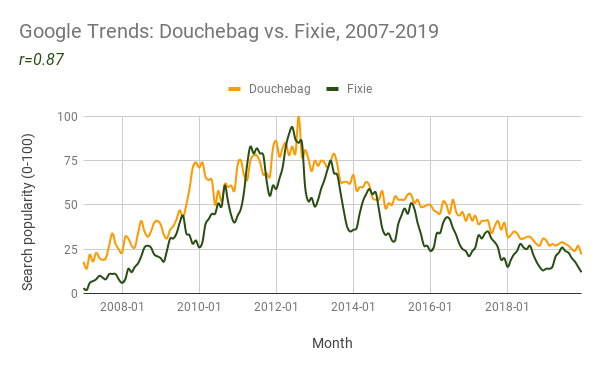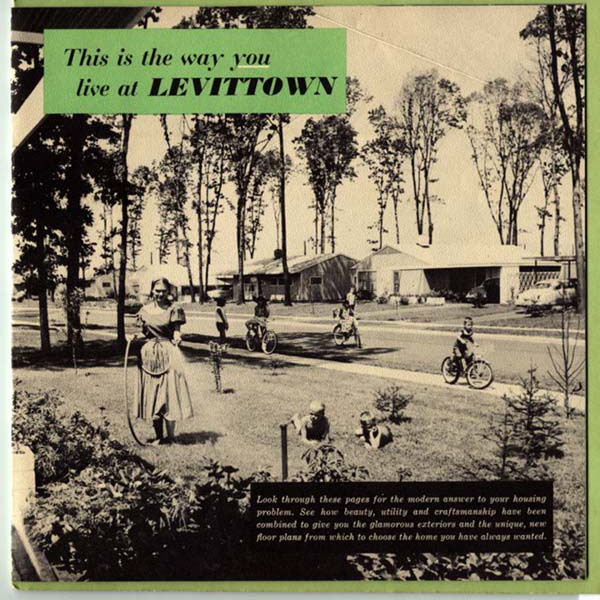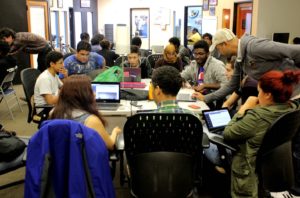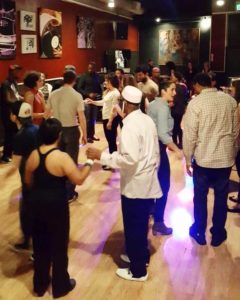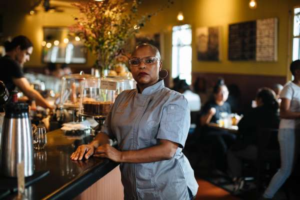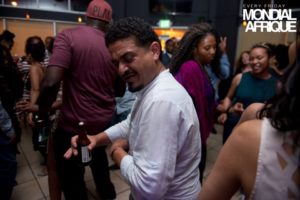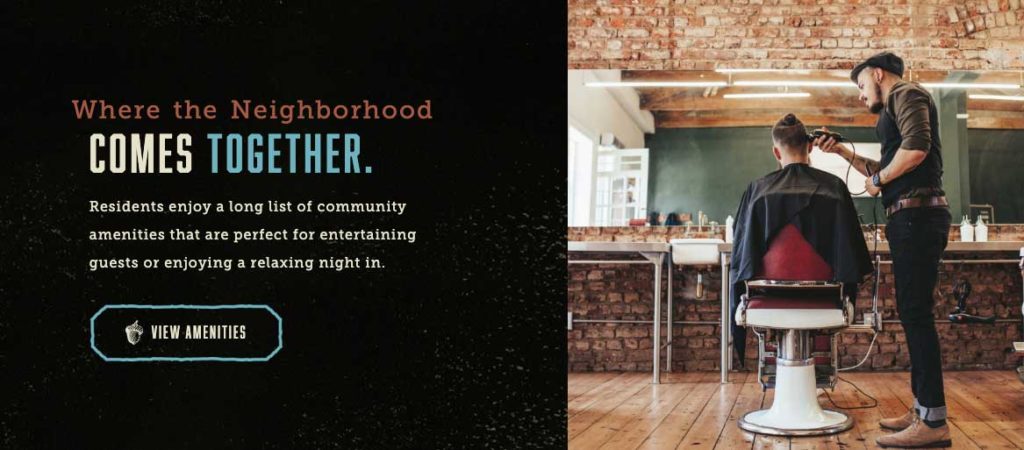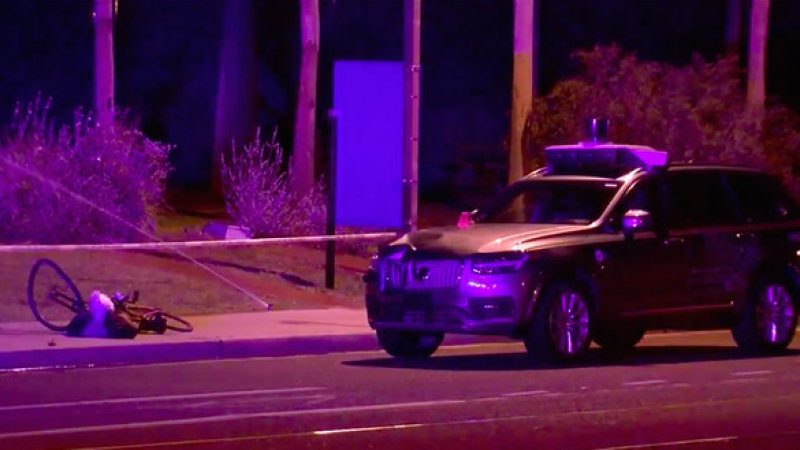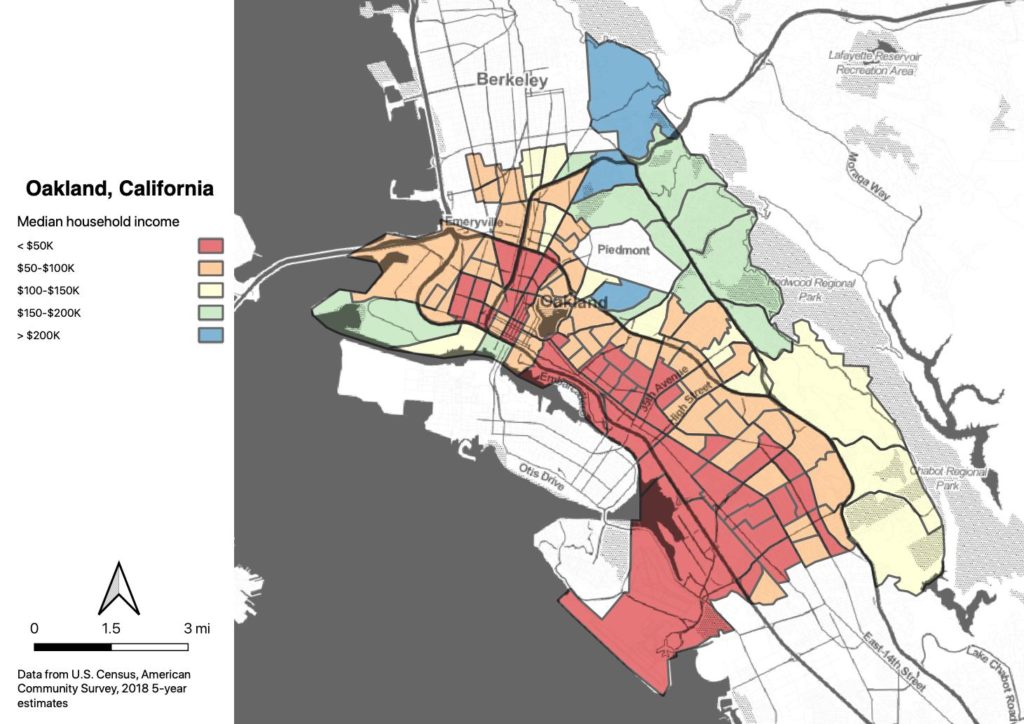(With apologies to Booker T. Washington)
As an urban critical theorist studying cycling cultures and neighborhood change, I’ve long been curious about the correlation between the terms “fixie” and “douchebag.”
Douchebag’s popularity as a pejorative is relatively new (though the use dates back to at least 1951), and its meaning is not entirely fixed, so I started asking people what they thought about the term. At least in my circles, the common themes were arrogance, privilege, and lack of self-awareness. The term is predominantly applied to white men, as noted in a wonderful deconstruction by Berkeley professor Michael Mark Cohen. Feminist critical theory being what it is, there is debate over whether the term is misogynistic, but I like Maddie McClouskey’s take that a douche (the quasi-medical device) is a misogynistic tool, which makes douchebag an appropriate pejorative term to refer to guys who are tools of the patriarchy.
My working definition is that douchiness is where entitlement meets cluelessness. The douchebag is a privileged person who feels entitled to that spot at the bar, that condo in the city, that job in tech, and that private bus to work which makes it all possible. And he is clueless about how his entitlement to those things pushes others out of the way.
In the bike world, these themes connect with my favorite Portlandia clip, which is really a brilliant piece of satire.
Design for Douchebags
The rise in popularity of douchebag coincides with a change in spatial regime. For the 50 years after WWII, the spatial ideal of the entitled American was the single-family suburban home. The suburb was explicitly racist, but suburban development was also partially a response to the perception that the central city was dirty and disease-ridden. And that was true to some extent, but as a result of the actions of industry and government, rather than the individuals living there. But the problems of urban overcrowding and urban decay became attributed to supposedly degenerate behaviors of urban dwellers, which affluent, entitled whites could avoid by separating themselves from the city.
The American suburb was marketed, first and foremost, as clean and controlled. Not only the people are white, but also the houses, the fences, and even the freeways. Move to the suburbs, these ads imply, so you and your family will be safe.
Many suburbs have gates and security guards, but even un-gated suburbs have implied, invisible walls to keep out the undesirable. Behavioral policing and cringe-worthy racism are still rampant today on the Nextdoor message board of any affluent suburb.
Because Black people were prevented from moving to the suburbs, they were later blamed for the degrading conditions of the cities the whites left behind. Trump, for example, still uses the term inner city as a synonym for the disinvested, decaying, Black ghetto.
The inner city has changed a lot in the past 20 years. Affluent Americans have renewed their interest in living in the central city, and capital has flowed into formerly disinvested neighborhoods. Some of this reinvestment manifests as gentrification—affluent individuals buying properties which were formerly rented or owned by the poor, spurring reinvestment in the neighborhood and displacement of those who lived there previously. In Oakland, gentrification is rampant along Martin Luther King Boulevard and in West Oakland. But the city is also experiencing other forms of reinvestment, particularly in downtown.
Along Broadway, properties which were formerly empty, vacant, or low-value commercial businesses like used car lots, are being redeveloped as apartment complexes. Oakland’s Broadway/Valdez Specific Plan, “envisions the district as a ‘complete’ neighborhood that supports socially- and economically-sustainable mixed use development; increases the generation and capture of local sales tax revenue.” [Note the explicit neoliberalism.] There are construction cranes all up and down the street, mostly building 5-6 story market-rate rental apartments. Jerry Brown’s “10K Plan” sought to bring 10,000 new residents to downtown Oakland, and Jerry was explicit that he wanted those units to be occupied by people with money. Current Mayor Libby Schaaf has said, “Oakland is ready to densify,” and Broadway/Valdez is one place that vision is being constructed. Most urbanists today support this kind of infill development; the powerful YIMBY movement seeks to force cities to build more of these types of market-rate quasi-urban apartment buildings.
I refer to them as quasi-urban because there are real ways in which these developments bring the moral aesthetics of the American suburb into their locations in the central city. The buildings are designed as insular, with private amenities and private security, and are often disconnected from the urbanity of the neighborhood in which they stand.
One such development is the Alexan Webster, a new apartment complex in uptown Oakland which markets itself as “Where the neighborhood comes together.” What they mean by that phrase is that the resident-only amenities are so compelling that residents will build a community within the development. Those amenities include a “hotel-inspired pool and spa,” a workspace, a shared kitchen, a rooftop deck, a fitness center, and a pet spa with dog run (you don’t have to leave, even to walk your dog!) The place is basically a Residence Inn, transplanted from Walnut Creek into downtown Oakland.
23rd and and Webster is a pretty diverse part of the city. Here are a few of the POC-serving and POC-owned businesses within a block or two of the Alexan Webster:
Instead of highlighting any of those places, here’s what the developer chose to illustrate “Where the Neighborhood Comes Together“.
Whoever produced the marketing clearly is clueless about the neighborhood; the website lists a number of shuttered businesses, and it also mentions the Oakland Zoo, which is as far away as you can possibly get and still be in Oakland.
And given a choice between a mentioning one of a large number of successful nearby businesses which are POC-owned and POC-catering, they decided to highlight probably the whitest business in all of downtown, a “luxury barbershop” (whatever that means) where you can get your mustache waxed by a white dude in cuffed-up skinny jeans and a tweed cap.
This is not an accident. This is exactly how you finance a luxury development in the city; by marketing it to entitled, affluent people with suburban values who are clueless about the place they’d be occupying. This is how corporations chase capital. If your target market is wealthy pseudo-urbanist douchebags, this is how you reach them.
Implications
I bring up the Alexan Webster not because it’s special—there are similar developments going up all over Oakland, San Francisco and Berkeley, and Sahra Sulaiman has done some great analysis of similar developments in South LA (“Even the dog is white!“, she comments on one set of renderings). I bring this development up because it was the site of an incident which demonstrates the problem of marketing your city to douchebags.
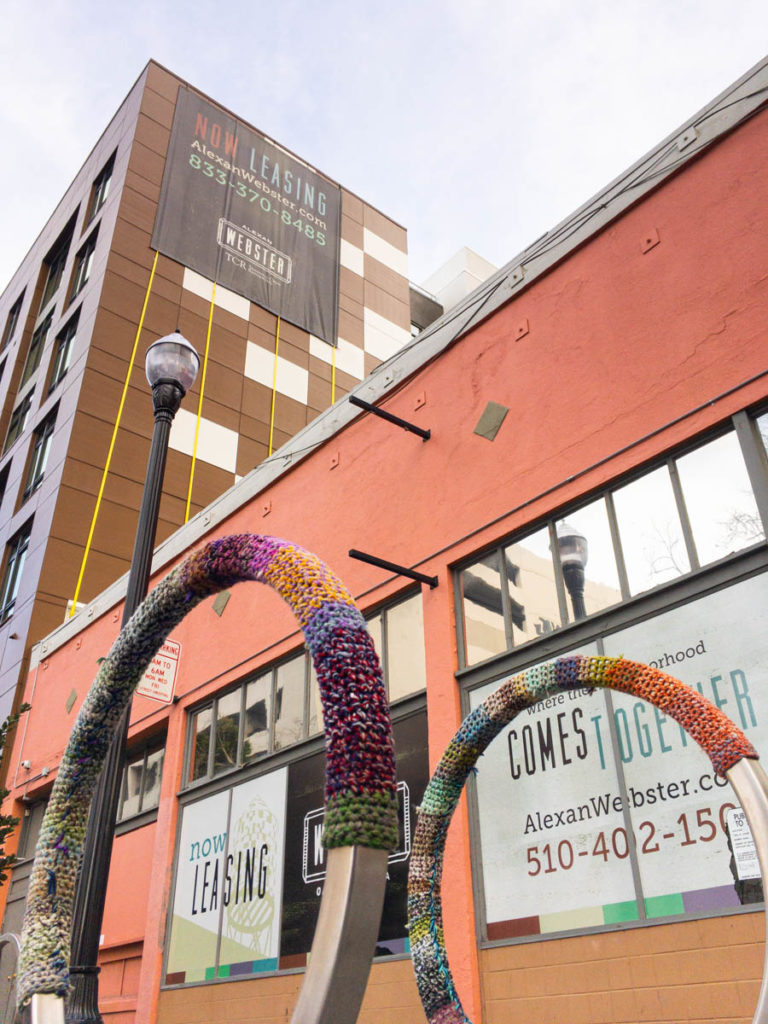
You may have heard the story of my colleague Kenya, who was accosted by armed security guards outside of the Alexan Webster. Kenya, who is Black, was taking pictures of a yarn bombing on new bike racks outside the building, when he was stopped, questioned, and confronted by the private guards. One drew his firearm. The situation thankfully resolved without violence, but Kenya was understandably shaken by the experience.
Kenya is a member of the Oakland Bicycle and Pedestrian Advisory Commission, and he and I work together on the Safety and Policing subcommittee, examining racial bias in Oakland Police Department discretionary stops. This incident shows that structural racism and its relationship to policing of Black bodies extends far beyond OPD. Kenya, a city planner who worked on Broadway/Valdez, is a native Oaklander who has personal relationships with many of the people in Oakland’s power structure. He received immediate response from a number of City Council members and Mayor Schaaf, and the Alexan Webster quickly fired their security company.
Most people understand the injustice of what happened to Kenya, and to Najari for that matter. But many fail to comprehend that these injustices are systemic, and that we all participate in these oppressive systems.
As Peggy McIntosh puts it, “I was taught to see racism only in individual acts of meanness, not in invisible systems conferring dominance on my group.” McIntosh, writing in 1989, uses the terms privilege and unearned advantage, which are part of the entitlement side of douchebag. But the most important part of her essay is sharing how she came to understand her own cluelessness about it.
After I realized the extent to which men work from a base of unacknowledged privilege, I understood that much of their oppressiveness was unconscious. Then I remembered the frequent charges from women of color that white women whom they encounter are oppressive.
I began to understand why we are justly seen as oppressive, even when we don’t see ourselves that way. I began to count the ways in which I enjoy unearned skin privilege and have been conditioned into oblivion about its existence.
My schooling gave me no training in seeing myself as an oppressor, as an unfairly advantaged person, or as a participant in a damaged culture.
McIntosh succinctly defines what I’m calling the Douchebag Problem. We exist in a society of structural racism and profound inequality. Everything we do is subject to those powerful, oppressive forces. And if we are unable to see how we contribute to and benefit from those forces, we will continue to perpetuate unjust systems.
The critical thing to understand is that fighting against suburbanism is not the same as fighting against the forces which created suburbanism. The creation of the suburbs and the freeways substantially enriched affluent white people, and severely damaged poor Black communities. Yet, if we tear down the freeways and rebuild the central city, we can expect that affluent white people will be substantially enriched, and poor Black communities will be severely damaged, again. Unless we do something about it.
The suburb isn’t inherently anti-Black any more than the central city is anti-White. The suburb of the 1950s was anti-Black because the power structures which invested in the suburbs wanted to exclude Black people. Now those same power structures are investing in the central city, and they want to exclude Black people in and around developments like the Alexan Webster.
The Douchebag Problem is that the people renting $3,000 studio apartments downtown are clueless about how their very existence in the city threatens the poor and Black people already living there. Affluent, entitled residents expect security guards to protect their private swimming pool and fitness center and rooftop bar, and as Kenya’s experience demonstrates, private security is subject to the same biases as OPD when policing of people of color.
Simply by existing, these developments change the rules of the street. Kenya’s own city has become more dangerous for him.
Implications for bike advocates
The U.S. bike advocacy movement is focused on building power in order to transform urban space. Unless the powerful forces of inequality and racism are contested, we can expect that bike advocacy victories will reinforce inequality and racism. Because that is what happens when power is applied in America.
For example, today in Chicago there is a battle over land around the 606 Trail, where the addition of a bike path to a formerly poor neighborhood spurred gentrification and displacement. Lynda Lopez has been involved with The 606 for some years now; she is currently reporting on efforts to place a moratorium on new demolition permits along the trail corridor, where housing prices have quadrupled in the past seven years. A similar outcome was observed at the Midtown Greenway in Minneapolis. As Aidil Ortiz put it at the Untokening this year, green infrastructure isn’t innocent; it exists within our racist and classist society and is subject to those forces. If we care about mobility justice, we need to contest those forces on an ongoing basis.
Urban spatial conflicts usually occur not between entitled and powerless groups, but between different entitled groups with differing values. The YIMBY movement which advocates for more developments like the Alexan Webster is one example; YIMBYs behave as if they are an oppressed group fighting against the NIMBY homeowner power structure, but in fact both YIMBYs and homeowners are entitled, in different ways, and their fight over urban space is a fight over whose entitlement will be manifest in the city. Most YIMBYs are clueless about why they encounter resistance from tenant’s rights and anti-displacement groups, and they rhetorically lump the interests of those groups in with homeowner NIMBYs, despite all evidence to the contrary.
Similarly, bike advocates see themselves as fighting oppressive auto-centric culture, and consistently fail to comprehend why they encounter resistance from poor people of color. Oppressions, McIntosh notes, are interlocking, and appear in “active forms, which we can see, and embedded forms, which as a member of the dominant group one is taught not to see.” To a bike-identified advocate, the experience of being at the bottom of the spatial hierarchy is an active form of oppression; it can be perceived and acted upon. This leads bike advocates (predominantly white, male, and affluent) to use the power which flows from multiple embedded forms of oppression to influence politicians to change the spatial hierarchy. The fact that poor people of color are structurally marginalized by this process is an embedded oppression; it has been so prevalent for so long that it is no longer visible. And if you’re part of a dominant group and you can’t see how you participate in that structure, you may be part of the Douchebag Problem.
Conclusion
I am not any kind of expert in how to avoid being a douchebag. I belong to most of the dominant groups of American society, and there are almost certainly ways that I remain clueless about how I perpetuate oppressive systems. When I reflect on my past behaviors I can see that I have participated in racism, misogyny, heteronormativity, and so on, and I’ve gained enough humility to accept that I am probably blind to oppressions that I still participate in and benefit from today.
Primarily, I try to be aware of the risks of equating my struggle with the struggles of others. I personally have not had to experience the oppressions faced by women, or Black people, or LGBTQ+ people, or Muslims or Latinos or any of the other marginalized groups in our society. And the history of activism is full of examples of powerful people, typically white dudes, getting what they want while pushing others out of the way. Don’t do that, I tell myself.
I try to spend time listening to marginalized people. It’s something that Twitter is actually good for. You can get exposure to all kinds of communities, and as long as you keep your mouth shut you can learn from them. I also try to practice listening during my field work, and try to authentically show up in disadvantaged communities.
And, as a member of multiple dominant groups, I have learned to view my own desires with suspicion. I would love to see the city have more cyclists and walkers, better public transit, more dense transit-oriented development, better cafes, and better beer. If I’m advocating for those things, I have to ask, how do they intersect with our oppressive systems? Are people who are affected by racism, sexism, poverty, or disability included in the vision? Are they at the table? Are they being empowered or disempowered? Are we repairing the damage of oppression or perpetuating it?
As a white dude, I can’t give up my status as a privileged individual. The best I can do is to try not to be clueless about it.

